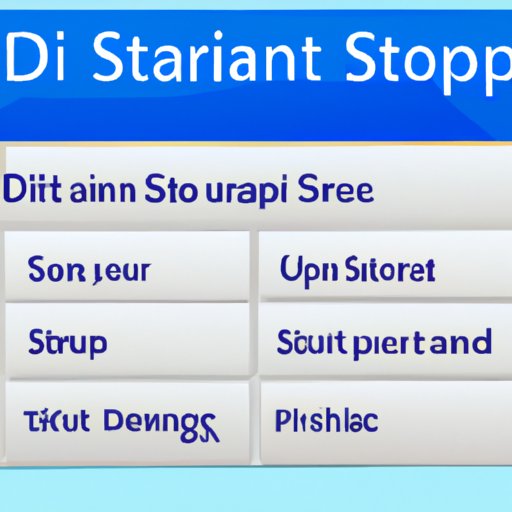Introduction
Desktop shortcuts are icons that appear on your computer’s desktop, which allow you to quickly open frequently used programs and websites. Creating desktop shortcuts can help you save time and make it easier to find what you’re looking for. In this article, we’ll cover the different ways you can create desktop shortcuts in Windows.

Use the “Create Shortcut” Feature in Windows
This is the most straightforward way to create a desktop shortcut. To get started, right-click anywhere on your desktop and select “New” from the context menu. You’ll see a list of options; select “Shortcut”.
Next, you’ll be prompted to enter the location of the item you want to create a shortcut for. For example, if you want to create a shortcut for Microsoft Word, you would enter the file path for the program (e.g., C:\Program Files\Microsoft Office\Office14\WINWORD.EXE). Once you’ve entered the location, click “Next”.
You’ll then be asked to enter a name for the shortcut. Enter a name that describes the program or website you’re creating a shortcut for (e.g., “Word”). Finally, click “Finish” to create the shortcut.
Create a Shortcut Using Drag and Drop
You can also create a desktop shortcut by dragging and dropping a file or program onto your desktop. To do this, open the folder containing the item you want to create a shortcut for. Then, simply drag and drop the item onto your desktop. Your computer will automatically create a shortcut with the same name as the item.

Utilize the “Send to Desktop” Option
The “Send to Desktop” option allows you to quickly create a desktop shortcut for any item located in your computer’s File Explorer. To use this feature, open the folder containing the item you want to create a shortcut for. Then, right-click the item and select “Send to” from the context menu. From the list of options, select “Desktop (create shortcut)”. Your computer will automatically create a shortcut with the same name as the item.
Use the “Pin to Start” Feature
The “Pin to Start” feature is available in Windows 10 and allows you to quickly create a desktop shortcut for any item located in your computer’s File Explorer. To use this feature, open the folder containing the item you want to create a shortcut for. Then, right-click the item and select “Pin to Start” from the context menu. Your computer will automatically create a shortcut with the same name as the item.
Right-click and Choose “Create Shortcut”
You can also create a desktop shortcut by right-clicking an item and selecting “Create Shortcut” from the context menu. To do this, open the folder containing the item you want to create a shortcut for. Then, right-click the item and select “Create Shortcut” from the context menu. Your computer will automatically create a shortcut with the same name as the item.

Take Advantage of Keyboard Shortcuts
Keyboard shortcuts are another quick and easy way to create desktop shortcuts. Most keyboard shortcuts involve pressing two or more keys simultaneously. For example, pressing the Windows key + D will instantly minimize all open windows and show the desktop. Pressing the Windows key + R will open the Run dialog box, which allows you to quickly open programs, files, and folders.
Install a Third-Party Application to Make Desktop Shortcuts
If you don’t want to go through the hassle of creating desktop shortcuts manually, you can install a third-party application that will do it for you. There are many popular applications available, such as Fences, DeskScapes, and ObjectDock. These applications allow you to quickly create desktop shortcuts by simply dragging and dropping items onto the desktop.
Once you’ve installed the application, you can customize the look of your desktop by adding background images, changing the size and color of icons, and organizing shortcuts into folders. Some applications even allow you to add widgets and create custom animations.
Conclusion
Creating desktop shortcuts can be a great way to quickly access your favorite programs and websites. This article has provided a step-by-step guide on how to create desktop shortcuts in Windows using various methods, including the “Create Shortcut” feature, drag and drop, the “Send to Desktop” option, the “Pin to Start” feature, right-clicking and choosing “Create Shortcut”, and using keyboard shortcuts. Additionally, you can install a third-party application to make creating desktop shortcuts even easier.
Using these methods, you can easily create shortcuts for all of your favorite programs and websites, making it easier to access them quickly. With desktop shortcuts, you can save time and make sure you always have quick and easy access to the programs and websites you need.


